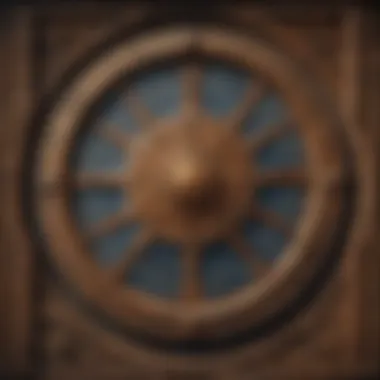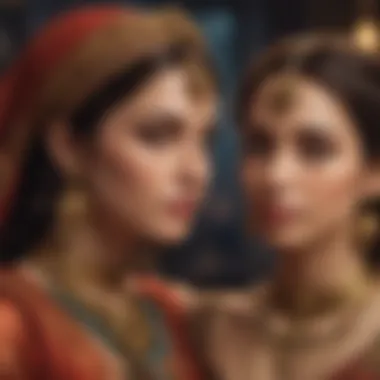Mastering Kundli Matchmaking: Insights and Techniques


Intro
The ancient art of matchmaking through Kundli holds a certain mystique, enticing those fascinated by the intertwining of celestial bodies and human relationships. The concept, deeply rooted in Indian Vedic astrology, operates on the premise that individual personalities, experiences, and potential futures are significantly influenced by astrological placements. This guide seeks to dissect that practice, shedding light on its historical context, methodologies, and modern-day applications, making it both relevant and engaging for astrology enthusiasts.
Understanding the intricacies of Kundli involves more than just interpreting star positions; it entails grasping how these placements interact to define compatibility between individuals. This exploration will pave the way for clear insights into how Kundli can serve as a beacon for personal relationships, ranging from romantic partnerships to workplace dynamics.
As the cosmic alignment of the stars shifts and turns, the importance of this age-old practice transforms, adapting to the technological realm we inhabit today. From astrological apps to vast online databases, technology continues to shape the way individuals engage with astrology, paving new paths for compatibility assessments. In a world where technology reigns supreme, will age-old practices stand the test of time? Stay with us as we unpack these layers, and illuminate the cosmic link between stars and human connections.
Intro to Matchmaking Kundli
The practice of matchmaking through Kundli holds significant value in various cultures, especially in Indian astrology. Kundli, commonly referred to as a birth chart, is a personalized astrological blueprint that lays out the unique positions of celestial bodies at the time of one's birth. It plays a pivotal role as it encapsulates one's destiny, personality traits, and potential challenges in life. Understanding the nuances of Kundli is essential not only for discerning individual paths but also for evaluating compatibility with potential partners.
Astrology enthusiasts and those seeking deeper insights into personal relationships will find the exploration of Kundli matchmaking particularly enlightening. This practice unveils layers of personality dynamics that might not be immediately obvious and allows individuals to make informed choices regarding their relationships. The assessment of compatibility is not just about finding a match; it is about ensuring that parties involved can harmoniously grow together.
In today's world, where personal preferences often clash with traditional beliefs, understanding Kundli matchmaking can serve as a bridge, facilitating a balanced approach. It empowers individuals to blend age-old practices with modern ideologies, thus enriching their love lives while respecting traditional values. Ultimately, this introductory section aims to underscore the importance of Kundli as a tool for meaningful connections, which can lead to lasting partnerships.
Understanding Kundli
Kundli amalgamates several astrological components, forming a complex yet insightful representation of an individual's life. At its core, a Kundli chart is divided into twelve houses, each corresponding to different life aspects such as career, relationships, and health. The planets embedded within these houses provide clarity on how these factors interplay in an individual’s life. The Ascendant, or the rising sign, is particularly significant as it shapes one's outward personality and how others perceive them.
For instance, if someone's Ascendant is Aries, they may exhibit traits like assertiveness and boldness, adding a layer of understanding in interactions with potential partners. It’s like having a map that guides one through the intricate paths of relationships.
Moreover, the position of planets, which changes based on time and space, adds further depth to the analysis. This allows one to scrutinize how planetary alignments may also influence not only personality but also compatibility with others, highlighting the multifaceted nature of human relationships.
Historical Context of Matchmaking in Astrology
The roots of Kundli matchmaking can be traced back to ancient civilizations where astrology was considered a sacred science. In India, the history of astrological practices is deeply intertwined with cultural customs and societal norms. For centuries, families preferred matches that resonated with astrological compatibilities, believing that such alignments ensured harmony and prosperity.
In a historical context, ancient texts document various methodologies concerning matchmaking. The Nadi astrology, for example, was aimed at predicting the future of individuals based on ancient palm leaves that detailed their destinies. It underscores the weight given to astrological alignments in determining fate.
As society progressed, so did the methods of matchmaking. While previously reliant solely on familial discretion, the shift towards more personalized approaches has occurred. Today, many seek their own compatibility checks via Kundli, often using modern technology to assist in these assessments. This evolution reflects a growing trend of marrying traditional wisdom with contemporary practices, keeping Kundli matchmaking relevant in today's fast-paced world.
Overall, the historical context showcases a rich tapestry of beliefs and practices that continue to shape how individuals approach relationships through the lens of astrology.
The Basics of Kundli
Understanding the basics of Kundli is essential for anyone looking to navigate the realm of astrological matchmaking. It serves as the foundation upon which compatibility is measured and analyzed in this practice. At its core, a Kundli is like a cosmic blueprint, reflecting not only one’s birth details but also the positions of celestial bodies at the moment of birth. By comprehending these fundamental aspects, individuals can gain insight into their personal relationships as well as their life’s trajectory.
When engaging with Kundli, it’s crucial to consider several key elements. These include the components of a Kundli chart, such as the ascendant, planets, and houses, and the significance of nakshatras. Each of these parts adds layers of meaning and complexity, making the task of matchmaking both an art and a science. Recognizing these components allows participants to engage thoughtfully in the matchmaking process, paving the way for relationships that can be harmonious and fulfilling.
Components of a Kundli Chart
Ascendant
The ascendant, or lagna, is often referred to as the rising sign. It is the zodiac sign that was rising on the eastern horizon at the time of one’s birth and plays a critical role in the personality and outward behavior of individuals. What makes the ascendant significant is its influence on first impressions and the initial approach to life's challenges. When considering a match, the ascendant gives insight into how the partners will perceive each other and the world around them.
A unique aspect of the ascendant is its ability to illuminate physical attributes and demeanor, often viewed as a reflection of one’s true self. For instance, individuals with a Leo ascendant typically exhibit confidence and warmth, making them quite likable. However, different ascendants come with their own set of advantages and limitations, which can influence compatibility.
Planets
In the realm of Kundli, planets are akin to actors on a stage, each influencing the narrative of one’s life story. The position of planets at birth depicts various aspects of personality traits, emotional tendencies, and life events. Take Venus, for example, which is linked to love and relationships. Its placement can reveal one’s approach to love, intimacy, and partnership.
When discussing planets, it’s important to note their interaction with each other and how they impact relationship dynamics. A critical consideration is whether or not the personal planets of each potential partner harmonize. The unique feature of planetary placements is that they can either complement or challenge one another. This is crucial for understanding relational strengths or predicting areas of potential conflict.
Houses
Houses in a Kundli chart represent different life areas, such as career, family, and relationships. Each house holds specific meanings, shaping how life’s events unfold for an individual. For example, the seventh house, often associated with partnerships and marriage, becomes particularly significant when analyzing compatibility.
The beauty of houses is their ability to provide a roadmap of an individual's life journey. They are also instrumental in matching partners since the houses from one Kundli can reflect the realities seen in another’s chart. That said, each house can present both opportunities and challenges, thus influencing how a couple interacts.
Significance of Nakshatras
Nakshatras, or lunar mansions, are another significant aspect of Kundli matchmaking. There are 27 nakshatras in total, each presenting characteristics that can deeply influence relational dynamics.


These lunar divisions carry unique attributes, often based on mythology and astronomy, providing an additional layer of analysis about compatibility. The positioning of both partners' moon signs within these nakshatras plays a role in understanding emotional connection and shared values. A strong nakshatra compatibility can indicate a profound understanding and bond, whereas misalignment may suggest challenges in communication or emotional expression.
Astrological Principles of Matchmaking
Understanding the astrological principles behind matchmaking is akin to deciphering a complex puzzle where celestial forces and personal dynamics intertwine. It is crucial to recognize how the alignment of planets impacts compatibility in relationships. Astrological principles serve as guiding stars, offering insights into the strengths and weaknesses inherent in potential unions.
One of the key elements here is planetary positions, which reflect unique energy influences that can define the character of a relationship. Depending on where the planets are positioned at the time of birth, individuals reveal distinct traits that may either clash or complement each other. Therefore, enhancing understanding of these placements can lead to a more harmonious partnership.
Another essential concept is the dosha classification, which assesses specific challenges that might surface between partners. By delving into these principles, individuals can build a framework for compatibility assessment that's rooted in ancient wisdom while still being practical in contemporary settings.
The Role of Planetary Positions
The placement of planets within a Kundli chart is more than mere astronomy; it serves as a cosmic blueprint for personal traits and potential compatibility. Each planet embodies certain energies, emanating qualities that are either favorable or adverse within relationship dynamics. For instance, strong influences from Venus might suggest romantic compatibility, while malefic aspects from Mars could signify potential conflicts.
Planetary conjunctions and aspects are integral to this understanding. They create a dance of relationship potentials. A conjunction of the Sun and Moon in one chart, for example, might point to a deep emotional connection, while a Saturn influence might suggest lessons through challenges. Thus, comprehending these dynamics can offer clarity on how best to nourish a relationship and what pitfalls to navigate.
Dosha and its Impact on Compatibility
When we discuss dosha in relation to matchmaking, we touch on a critical aspect that can sometimes act as a fundamental stepping stone to harmony or discord.
Mangal Dosha
Mangal Dosha, which arises from the position of Mars, can be perceived through different lenses. One key characteristic is its association with aggression and assertiveness. In astrological matchmaking, individuals with Mangal Dosha may face compatibility challenges that stem from these traits, potentially leading to conflicts if not addressed tactfully.
Despite its negative connotations, Mangal Dosha can yield some surprising benefits. For one, it often instills resilience, and partners with this dosha may have a drive for success that can be channeled into fruitful endeavors together. However, awareness and communication become essential to mitigate its impact—especially during challenging times.
Kalasarpa Dosha
Kalasarpa Dosha presents another intriguing aspect of astrological compatibility. Its key characteristic lies in the positioning of planets between the nodes of Rahu and Ketu, suggesting certain karmic imbalances that can affect relationships. The energies surrounding this dosha can result in feelings of restriction or confusion within partnerships.
Nonetheless, Kalasarpa Dosha can also usher in opportunities for profound growth. Couples may find themselves navigating transformative experiences that teach them the importance of patience and understanding. The unique feature of this dosha is its capacity to change perspectives, granting partners a chance to reevaluate priorities and strengthen their bond in the process.
Methods of Analyzing Kundli for Matchmaking
Analyzing Kundli for matchmaking is fundamental for harmonious relationships in many cultures, particularly in India. This section focuses on how this ancient practice evaluates compatibility between prospective partners, bringing to light specific methodologies that both astrologers and individuals use. The insights gained from this analysis can significantly influence personal and familial decisions regarding marriage.
Comparative Analysis of Kundli
The comparative analysis of Kundli essentially refers to examining the horoscopes of two individuals side by side. It allows one to assess how their celestial positions interact with one another, revealing essential compatibility factors. One important aspect of this analysis is understanding the planetary placements within each chart. For instance, if both individuals have strong Venus placements, known for love and beauty, this could be a positive indicator of their potential to connect emotionally.
Besides planetary positions, it’s critical to look at the houses involved in each person’s chart. If pivotal houses for relationships, like the seventh house, show favorable conditions for both charts, this bodes well for the union.
Doing this comparative analysis can also unveil potential issues. If one partner has significant malefic influences in their chart while the other has beneficial influences, it may lead to an imbalance in the relationship dynamics. In such cases, astrologers can suggest remedies or acknowledge these concerns as barriers to consider before proceeding with marriage.
Guna Milan: The Compatibility Score
One of the most recognized methods for estimating compatibility in matchmaking is Guna Milan. This method assigns a compatibility score based on various factors, each addressing different aspects of a potential relationship. Here we’ll break down its components to examine how they function in assessing compatibility.
Varna
Varna categorizes partners into four groups based on their qualities: Brahmins, Kshatriyas, Vaishyas, and Shudras. This classification fundamentally determines compatibility, as it aligns with the overall temperament of individuals. The key characteristic of Varna is that it helps facilitate a balanced partnership; for instance, a Brahmin might harmonize well with a Kshatriya partner due to complementary qualities in leadership and wisdom.
It’s a beneficial choice in matchmaking because it establishes a societal standard that many find comforting. However, it can sometimes limit choices, especially if one is strictly adhering to these classifications, which may not always reflect personal characteristics and aspirations.
Vashya
Vashya assesses the power dynamics between partners, determining who holds more influence in the relationship. The primary characteristic here is whether one person can naturally lead or guide the other. If both individuals are found to resonate positively with each other in this aspect, it fosters a sense of mutual respect and partnership.
People often find Vashya an attractive aspect in matchmaking since it hints at long-term harmony based on trust and understanding. However, misalignment can lead to power struggles, making it critical to evaluate before entering a commitment.
Tara
Tara examines the lunar constellations of the partners at birth, further breaking down emotional compatibility. The core of Tara is tied to the moon’s positioning, reflecting how partners may react emotionally and spiritually to life events. A positive Tara connection can indicate mutual support and understanding during life's ups and downs.


This factor stands out as particularly beneficial because it goes beyond mere physical connection. A strong Tara analysis can foreshadow a nurturing environment for both parties, while a lack of alignment might signal potential emotional challenges down the line.
Yoni
Yoni represents the sexual compatibility and instinctual attraction between partners. This aspect hinges on individual passions and emotional closeness and is often thought of as fundamental for a healthy relationship. The pivotal characteristic of Yoni is its focus on intimacy, which plays a significant role in sustaining long-term relationships.
It is popular in matchmaking practices due to its straightforward nature, leading to open discussions about physical chemistry. However, over-emphasizing Yoni without considering emotional aspects might result in volatility in the relationship.
Graha Maitri
Graha Maitri points to the friendship between the planets in both charts, primarily focusing on positioning and aspects that facilitate harmonious interactions. Its importance lies in determining how easily partners can communicate and support each other. A favorable Graha Maitri signifies a level of compatibility that helps foster a nurturing relationship.
Graha Maitri serves as a practical aspect since it reflects the day-to-day dynamics between partners, making it a sound measure in examining whether a relationship could withstand external pressures. Notably, it should be evaluated alongside other factors for a well-rounded assessment.
The combined insights of Guna Milan offer a framework for choosing a partner while paying respect to both individual traits and broader cosmic influences, achieving balance in relationships.
By understanding the various components and methodologies of analyzing Kundli for matchmaking, prospective partners can navigate their paths toward a successful union, enriched by astrological knowledge.
Cultural Perspectives on Matchmaking
Cultural perspectives on matchmaking serve as the lens through which we view the practice of Kundli analysis. Matchmaking is not merely a personal choice; it’s heavily influenced by cultural beliefs and societal norms. Understanding these perspectives enables us to grasp the motivations behind certain practices and preferences. In many societies, the alignment of stars and planets doesn’t just determine compatibility; it connects individuals to their ancestral roots and collective narratives.
One prominent feature in various cultures is the role of astrology. For instance, in India, many still adhere strictly to the traditions of matchmaking based on Kundli. Family discussions often revolve around the compatibility of charts, with parents taking an active role in helping their children find a suitable spouse. This approach not only echoes a deep-seated belief in astrology but also reflects collective values regarding marriage. It emphasizes family harmony over individual choice, often touted as beneficial for long-term compatibility.
Similarly, in Western cultures, while astrology may not play as dominant a role, the influence of cultural background can be significant. Many individuals believe in soul mates or use online personality tests that incorporate astrological elements, indicating how deeply intertwined cultural beliefs shape their views on relationships.
The understanding of these cultural dimensions is essential because:
- It highlights the diversity in approaches to finding a match.
- It sheds light on how societal pressures influence personal decisions in relationships.
- It encourages openness and respect for varying practices, fostering better cross-cultural communications in modern relationships.
"Cultural beliefs often act as a compass, guiding individuals through the complex terrain of love and relationships."
Regional Variations in Kundli Practices
The regional variations in Kundli practices underscore the rich tapestry of beliefs and customs found across different cultures. In India, for instance, variations can be observed not only between states but also among communities. The South Indian approach significantly differs from that of North India, with unique practices like Jathakam being central in the South, whereas the North often emphasizes Lagna or the ascendant sign.
In Rajasthan, families may focus more on aspects like Gotra (clan lineage) when analyzing Kundlis, while in Gujarat, the emphasis might lean towards planetary positions. Additionally, in Bengal and other Eastern states, traditions often include specific rituals and ceremonies tied to the Kundli-analysis process.
These practices highlight how cultural nuances shape the expectations and rituals associated with matrimony:
- Personal interaction: In some areas, families meet before the Kundli analysis to discuss backgrounds.
- Integration of rituals: Rituals might be performed to strengthen celestial alignments believed to influence matrimonial harmony.
This diversity presents a fascinating area for exploration, revealing how deeply rooted cultural practices influence individuals’ views on matchmaking through Kundli.
The Influence of Tradition and Modernization
Tradition and modernization often find themselves in a delicate dance when it comes to matchmaking. On one hand, traditional values insist on celestial alignments and familial approval; on the other hand, modernization encourages personal autonomy and choice.
In many communities, people are beginning to blend these aspects, retaining their traditional practices while embracing modern conveniences. For example, digital platforms that analyze Kundli compatibility have emerged, allowing individuals to access analysis without the need for extensive family discussions. This provides a unique blend of both worlds, giving individuals the freedom of choice while still allowing them to respect astrological guidance.
However, challenges arise. Individual desires can clash with familial expectations and traditions. Many young people may feel torn between respecting their ancestors’ beliefs and pursuing relationships based on personal preferences. As they navigate this tension, they often find themselves at a crossroads, debating whether to please tradition or define their unique path.
In summary, the intersection of tradition and modernization in the context of matchmaking is complex. As societal norms continue to evolve, it’s essential to remain sensitive to both aspects of the choice, creating a collaborative space where both tradition and individuality can coexist.
Challenges in Modern Matchmaking
In the contemporary landscape of relationships, matchmaking through Kundli encounters unique challenges that intertwine personal beliefs with societal expectations. The intersection of tradition and modernity compels individuals to navigate a delicate balance, demanding a thoughtful approach to compatibility assessments. As communities evolve, the means through which people engage with astrological practices also transform, prompting discussions on how these changes impact personal choices and collective perspectives.
Balancing Traditional Beliefs and Personal Preferences
One of the primary challenges in modern matchmaking is the clash between traditional beliefs and personal preferences. For many, Kundli matchmaking represents a time-honored practice steeped in cultural significance. However, there is an increasing inclination among individuals to prioritize personal compatibility over traditional criteria. This shift can lead to friction within families, particularly in cultures where arranged marriages are the norm.
Individuals faced with matchmaking decisions often find themselves at a crossroads.


- Considerations of compatibility: Often, people want to harmonize their astrological readings with their actual feelings and aspirations, leading to a reevaluation of what factors are truly important in finding a partner.
- Generational differences: Younger generations may lean towards self-determination rooted in love and personal choice, challenging the norms upheld by their elders.
This tug-of-war can shape the matchmaking narrative, leading to a more personalized approach that still acknowledges the historical weight of traditional practices. Families must come to terms with these changing dynamics, fostering discussions that embrace both traditional values and modern sensibilities.
The Impact of Technology on Kundli Analysis
Technological advancement has significantly influenced Kundli analysis, introducing new methodologies that both simplify and complicate the process. In an age where everything is at our fingertips, these changes reshape how individuals interact with astrology, making it more accessible but also challenging its authenticity.
Online Kundli Services
Online Kundli services have emerged as a popular choice among seekers looking for quick astrological insights.
These platforms facilitate a broader reach, allowing individuals to obtain personalized Kundli readings without the necessity of in-person consultations. A significant characteristic of these services is their ability to cater to an audience looking for instant gratification.
- Convenience: Users can initiate their Kundli analysis from the comfort of their own homes at any time, removing barriers like geographical constraints.
- Accessibility: Online platforms often provide free basic readings, which encourages experimentation for those unfamiliar with astrology but interested in exploring it.
However, a notable trade-off with online services is the potential loss of individual attention. Many users may find that automated systems cannot fully grasp the nuances of their personal situations, leading to generic readings that might miss key aspects of their personality or relationship goals.
Astrological Software
Astrological software offers a more sophisticated approach, enabling keen enthusiasts to conduct in-depth analyses on their own or with guidance. These programs typically feature advanced algorithms to interpret intricate astrological data.
- Key characteristic: Versatility stands out in astrological software, as it allows users to experiment with various calculation methods and preferences in real-time.
- Added depth: Users can analyze not just compatibility scores but also other factors, like transits and progressions, expanding their understanding of day-to-day influences.
While astrological software may provide richer insights, there's a learning curve that can deter novice users. Those unacquainted with astrology may feel overwhelmed by the complexity, which can lead to misinterpretation of the results.
Case Studies of Successful Matchmaking
In the realm of Kundli matchmaking, case studies serve as a lens into the practical applications of astrological principles. They shine a light on how this ancient practice can lead to harmonious partnerships and successful marriages. By closely examining these real-life examples, one can appreciate the intricate dance between celestial patterns and earthly relationships. This section delves into various components that make these case studies especially valuable, including the diversity of backgrounds, the effective application of astrological insights, and the lessons drawn from both triumphs and challenges.
Real-Life Examples from Diverse Backgrounds
Exploring matchmaking through Kundli doesn't happen in a one-size-fits-all approach. Different cultures interpret these celestial alignments uniquely, and this diversity adds richness to the practice. For instance, consider the case of Ramesh and Simran, an intercultural couple from the city of Delhi. Ramesh adheres to strict traditional values, while Simran embraces a more contemporary outlook.
Despite their differences, they found grounding in their Kundli readings, which revealed complementary planetary positions. Their astrological match indicated a strong bond reinforced by shared values, paving a road to mutual respect. Such instances underline how Kundli analysis can bridge various cultural narratives, fostering connections that may seem unlikely at first.
In another case, Priya from a rural background and Aakash from an urban backdrop learned to navigate their differences through a thorough examination of their Kundlis. Their astrologer pointed out specific astrological alignments, emphasizing their innate strengths and areas of compatibility. Together, they chose to delve into their individual characteristics while respecting each other's traditions. This showcases the potential for Kundli matchmaking to enhance understanding and acceptance in relationships.
Learning from Failures in Matchmaking
Not every match made in astrological heaven ends up being successful. In fact, studying failed matches offers invaluable insights that can enhance understanding of the matchmaking process. One notable example involves Neha and Vikram, who disregarded several red flags during their Kundli analysis. Their assessment indicated the presence of Mangal Dosha, a condition often viewed as a potential disruptor in a relationship.
In their eagerness to tie the knot, they overlooked this critical detail, leading to numerous conflicts after marriage. The failure of their partnership serves as a crucial case for emphasizing the significance of addressing astrological warnings.
Learning from such instances can be enlightening for prospective couples. One must consider that compatibility isn't solely about personal feelings; it’s deeply intertwined with cosmic forces. It's important for individuals to take a holistic view—both the emotional aspect of their relationship and the astrological insights garnered through Kundli.
Ultimately, these case studies offer a tapestry of narratives that resonate with potential partners. They reveal that successful matchmaking through Kundli transcends mere calculations; it is an evolving practice that thrives on understanding, respect, and the willingness to learn from both wins and losses.
Kundli matchmaking is not just about finding an astrological match; it is about discovering one another as individuals.
Final Thoughts on Kundli and Matchmaking
In wrapping up our exploration of matchmaking through Kundli, it is essential to underscore the multifaceted nature of this practice. Kundli matchmaking serves as much more than a mere assessment of celestial alignments; it is a holistic framework deeply rooted in culture, tradition, and personal belief systems. As we’ve navigated through the various sections of this guide, we have seen how essential it is to integrate ancient wisdom with contemporary views. This blend is not just an aspect of spiritual fulfillment but also of practical relationship mechanics.
Astrological matchmaking can offer clear benefits such as heightened understanding of compatibility, but it also comes with certain considerations. For instance, one must balance reliance on astrological principles with personal agency. After all, one's individual choices and emotional intelligence play critical roles in the fabric of any relationship. Understanding this spectrum helps to craft a more nuanced approach to matchmaking, one that appreciates tradition yet embraces modernity.
The Future of Astrological Matchmaking
The future of astrological matchmaking looks to be both promising and challenging. As society evolves, so too does the perception of astrology. Younger generations might view Kundli analysis through a different lens—one that prioritizes emotional intelligence over rigid traditional standards. This shift implies that astrology must also adapt. With the increasing integration of technology, a new online dynamic is emerging.
In recent years, digital platforms for Kundli services have sprung up, catering to a wide audience. Whether through online consultations or mobile applications, accessibility has dramatically increased.
However, this rise in digital services raises questions about authenticity and accuracy. Will the quality of analysis diminish in favor of convenience?
Moreover, the influence of artificial intelligence could significantly change how practitioners interpret Kundli charts, possibly introducing algorithm-driven matchmaking services. This could lead to faster analyses but may sacrifice the deep, personalized touch that many find invaluable.
Ultimately, the future will likely require a well-balanced intersection of technology and human intuition, where users can embrace both scientific and intuitive approaches to their matrimonial compatibility.
Concluding Remarks on Kundli Practices
Reflecting on our journey through the world of Kundli matchmaking, it's clear that its practices extend far beyond the calculation of planetary positions. They encompass a rich tapestry of cultural significance, emotional depth, and spiritual insight. In understanding Kundli, one begins to appreciate the intricate dance between fate and free will in human relationships.
As those who are seeking guidance through astrological matchmaking, it’s important to approach these practices with an open mind yet a discerning outlook. Be mindful of the layers of interpretation that exist within your own Kundli. This self-awareness can lead to deeper insights about personal strengths, weaknesses, and the dynamics of potential relationships. Remember, while the stars provide guidance, it's the choices we make that truly shape our destinies.
By building a bridge between past traditions and future innovations, one can make the most of Kundli matchmaking as a tool for personal growth and relationship success. Embrace the information, engage thoughtfully with it, and let it inform your path forward in love and partnership.



